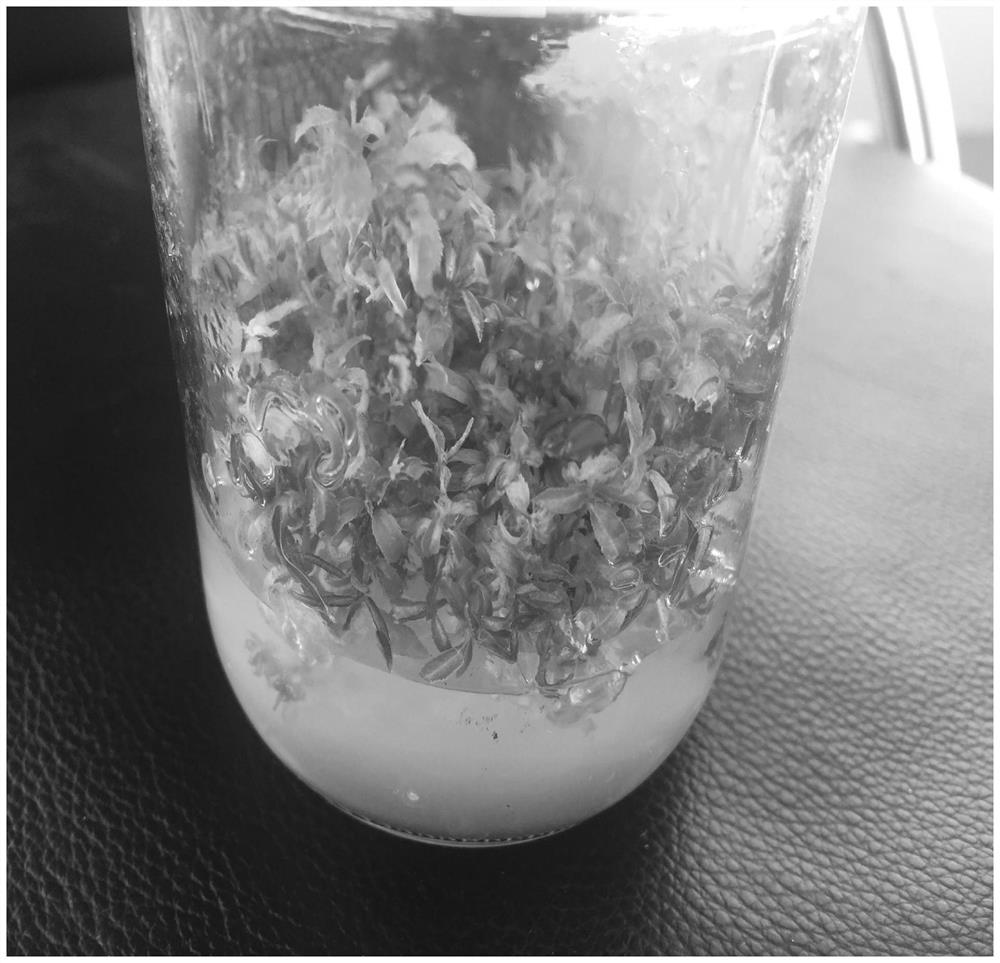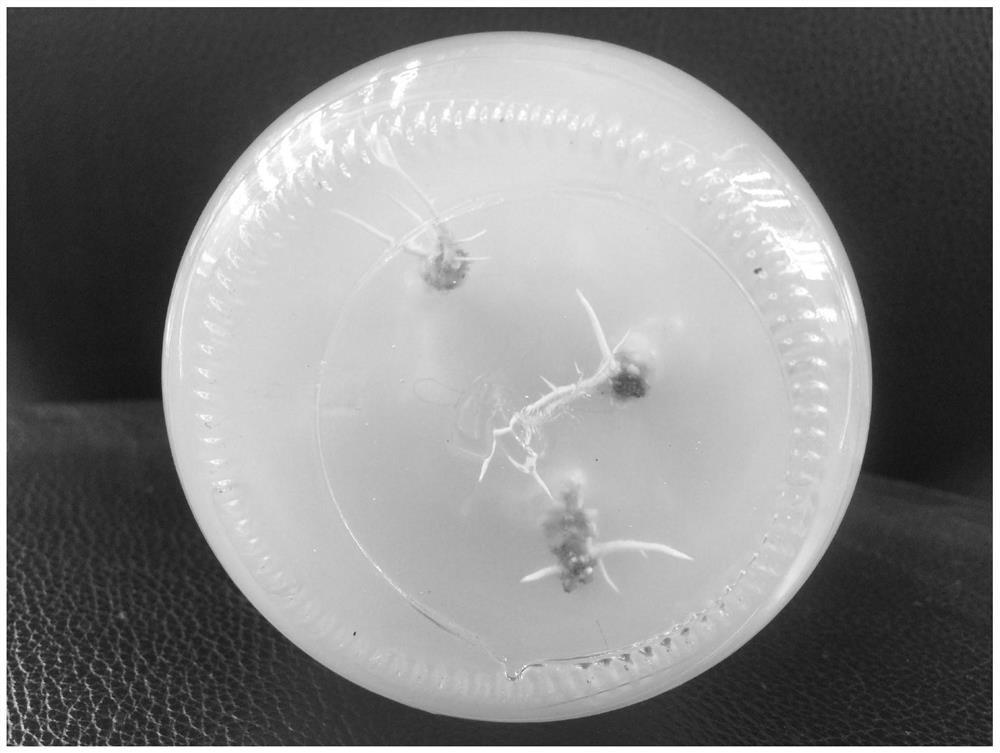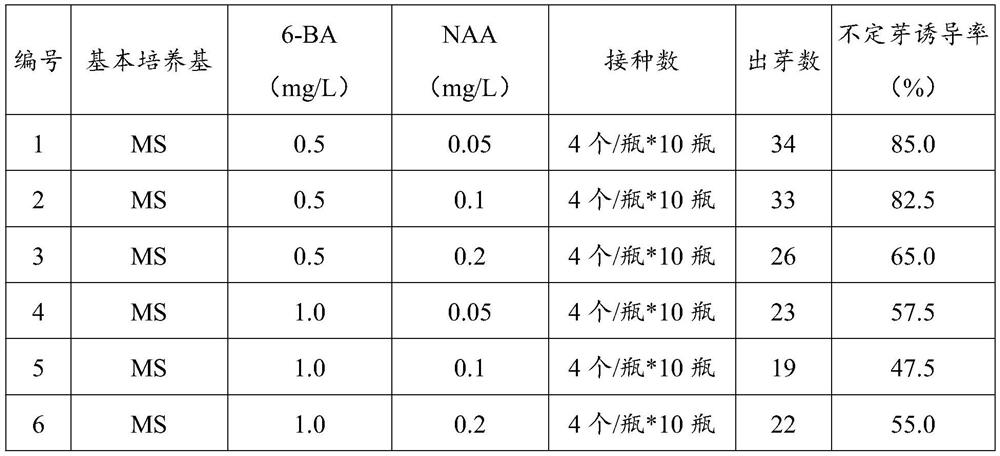Rapid cerasus humilis tissue culture method
A technology of tissue culture and eucalyptus, applied in the field of plant tissue culture, can solve problems such as unsatisfactory reproduction efficiency of eucalyptus tissue and inability to meet demand and so on.
- Summary
- Abstract
- Description
- Claims
- Application Information
AI Technical Summary
Problems solved by technology
Method used
Image
Examples
Embodiment 1
[0051] A kind of fast Oligo tissue culture method
[0052] 1. Culture of explants
[0053] Remove the outer testa of the collected Plum seeds, transfer them to a sterilized container on an ultra-clean workbench, disinfect with 70% alcohol for 10 seconds, and rinse with sterile water for 3 times; then disinfect with 0.1% mercuric chloride solution 5min, rinse with sterile water 5 times. Inoculate the sterilized seeds on the pre-prepared MS medium (without any hormones), cultivate under the condition of 13 light / 11 dark, the light intensity is 2500Lx, the temperature is 25°C, and the humidity is 40% for cultivation . After 15 days, when the seeds germinate and the seedlings grow to about 2 cm, the seedlings are cut into sections of about 1.0 cm, and each section retains at least one axillary bud, which is used as an explant to induce the proliferation of adventitious buds.
[0054] 2. Induction of adventitious buds
[0055] The obtained seedling segments were used as explant...
Embodiment 2
[0063] 1. Culture of explants
[0064] Remove the outer testa of the collected Plum seeds, transfer them to a sterilized container on an ultra-clean workbench, disinfect with 75% alcohol for 10 seconds, and rinse with sterile water for 3 times; then disinfect with 0.1% mercuric chloride solution 5min, rinse with sterile water 5 times. The sterilized seeds were inoculated on the pre-prepared MS medium without any hormone, and cultivated under the conditions of 13 / 11h light, light intensity of 2500Lx, temperature of 24°C, and humidity of 50%. After 15 days, when the seeds germinate and the seedlings grow to about 2 cm, the seedlings are cut into sections of about 1.0 cm, and each section retains at least one axillary bud, which is used as an explant to induce the proliferation of adventitious buds.
[0065] 2. Induction of adventitious buds
[0066] The seedling segments were inoculated on the pre-prepared proliferation medium. The medium formula is MS+6-BA1.0mg / L+NAA0.05mg / L...
Embodiment 3
[0074] 1. Culture of explants
[0075] Remove the outer testa of the collected Plum seeds, transfer them to a sterilized container on an ultra-clean workbench, disinfect with 75% alcohol for 10 seconds, and rinse with sterile water for 3 times; then disinfect with 0.1% mercuric chloride solution 5min, rinse with sterile water 5 times. The sterilized seeds were inoculated on the pre-prepared MS medium without any hormone, and cultivated under the conditions of 13 / 11h light, light intensity of 2500Lx, temperature of 26°C, and humidity of 45%. After 15 days, when the seeds germinate and the seedlings grow to about 2 cm, the seedlings are cut into sections of about 1.0 cm, and each section retains at least one axillary bud, which is used as an explant to induce the proliferation of adventitious buds.
[0076] 2. Induction of adventitious buds
[0077] The seedling segments were inoculated on the pre-prepared proliferation medium. The medium formula is MS+6-BA0.7mg / L+NAA0.05mg / L...
PUM
 Login to View More
Login to View More Abstract
Description
Claims
Application Information
 Login to View More
Login to View More - R&D
- Intellectual Property
- Life Sciences
- Materials
- Tech Scout
- Unparalleled Data Quality
- Higher Quality Content
- 60% Fewer Hallucinations
Browse by: Latest US Patents, China's latest patents, Technical Efficacy Thesaurus, Application Domain, Technology Topic, Popular Technical Reports.
© 2025 PatSnap. All rights reserved.Legal|Privacy policy|Modern Slavery Act Transparency Statement|Sitemap|About US| Contact US: help@patsnap.com



